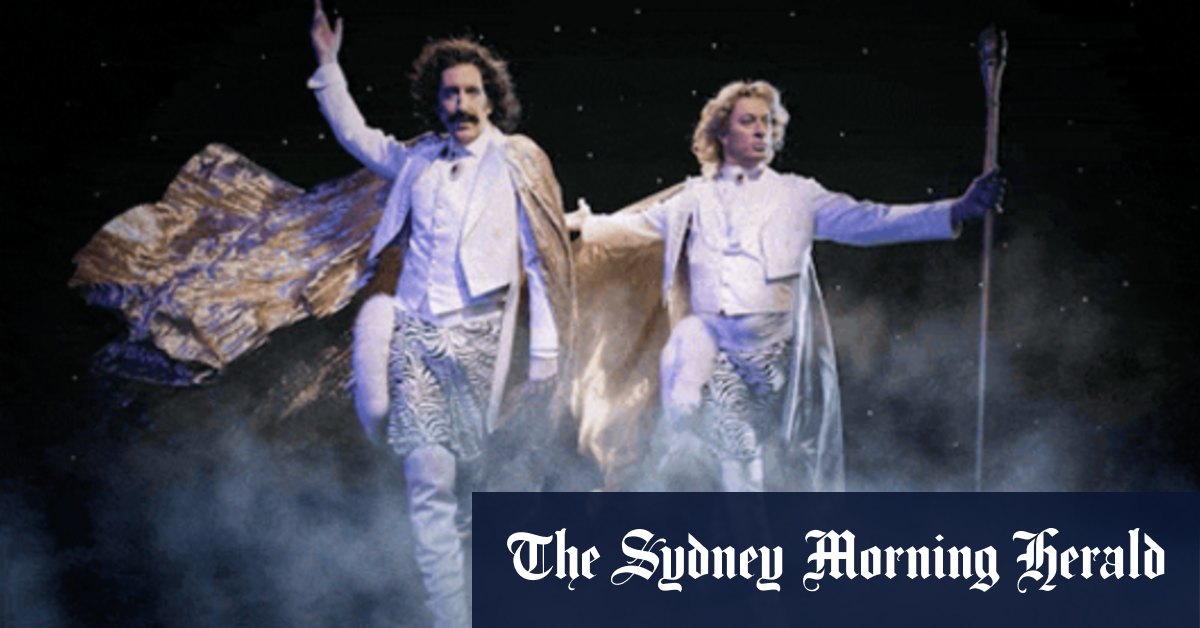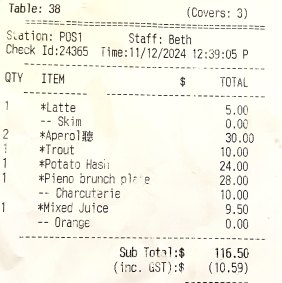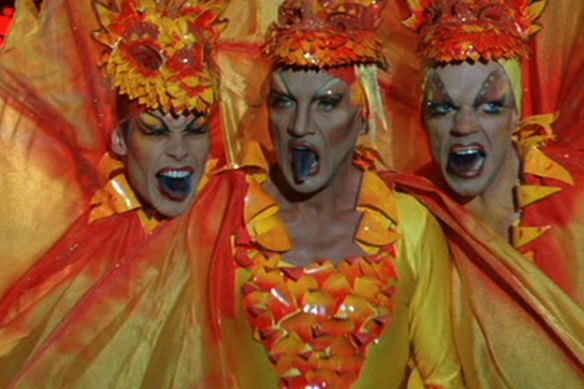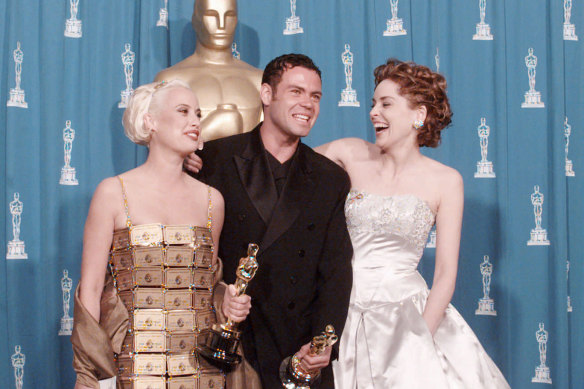
He grew up as an “army brat” whose family regularly moved to new bases around the country. His late father, Murray, was a warrant officer first class; his mother, Diane, worked at Target (which later meant Chappel got a staff discount for the thongs used to make a famous Priscilla costume); he has a sister, Melissa, and a brother, Cameron.
“I spent a lot of time alone as a kid,” he says. “I wouldn’t say I was lonely. I just didn’t have a lot of friends. So I got really into insects and flowers and the beautiful things of nature.”

Pretty charcuterie at Pieno.Credit: Dion Georgopoulos
Chappel was also into crafts, including knitting, crochet and digging up clay in the backyard to build a mudbrick house. He was planning to become a botanist until a chance discovery in Melbourne at the age of 14.
“It’s such a cliche, but I found a French Vogue on the Flinders Street Station platform and I opened it and went, ‘Oh, I’m going to do this’,” he says. “It was a kind of glamour that I’d never experienced. I could see the way the clothes sat on the people and I went, ‘I could do that’.”
Chappel later discovered a family connection, which makes him think there was a genetic aspect to his career. “I found out after my family were disappointed that I decided to go to college and do fashion that my grandfather and his father before him were tailors,” he says. “I wonder if serial killers’ grandchildren do the same thing.”
Having started studying at Sydney College of the Arts, Chappel dropped out when he landed a job in TV, designing clothes for the series E Street. His breakthrough was a wedding dress for Abby Rossiter, played by Chelsea Brown, which caught fire when someone hung it over the incandescent lights of a makeup mirror.

Potato and green hash with hot smoked trout.Credit: Dion Georgopoulos
“Fortunately, I’d lined it with calico so it didn’t burn all the way through,” he says. “And, fortunately, I brought all the scraps so I made a decorative panel. That made me realise it’s a skill that I don’t have to try to do; I just do it.”
In the early 1990s, Chappel was making costumes for drag queens and shorts for the bartenders at the Albury Hotel, then a leading gay venue. “I came up with this concept that made everybody look more ‘lunchy’ than they actually were – a built-in shelf,” he says. “The bigger the lunchbox, the better the tips.”
Elliott, then an acquaintance , came in one night, said he was making a film and asked if Chappel would do the costumes.
Initially dubious, he and Gardiner designed – over the 18 months it took to line up the financing – the dazzling costumes that two drag queens (Weaving and Pearce) and a transgender woman (Stamp) wear as they travel from Sydney to Alice Springs in a bus they call Priscilla.

The bill.
“Oddly enough, Stephan and I were on totally different pages,” Chappel says. “He wanted it to be really pretty in a Les Girls [female impersonation] way and I wanted to represent the Sydney drag culture that was around at that time, which wasn’t really about looking like a woman. It was to look really interesting with this punk attitude to sexuality. It was a really great time in Sydney for creativity and I just channelled it. ”
When the film’s success took them to the Oscars, Chappel and Gardiner were certain they were not going to win. They expected the Oscar would go to France’s Queen Margot, which had “exquisite costumes” compared with “our stuff, which was chicken wire and hot glue”.
But when they arrived at the theatre and took their seats, they realised they were going to win.
“When they sit you down, they were like ‘you two, don’t move’,” Chappel says. “Behind us were all the other nominees, some in giant gowns. I thought, ‘She’s clearly not going anywhere because she’s 10, 12 people in.’ There was no way she was going to get out. And we were in front of them by ourselves.

Guy Pearce, Terence Stamp and Hugo Weaving in The Adventures of Priscilla: Queen of the Desert.Credit: Elise Lockwood, National Film and Sound Archive
“I was like, ‘Oh shit, Lizzie’ and she said ‘Don’t say it, you’re going to jinx us’.”
When their names were called out, “it was like in a war film and a bomb goes off and everything goes white”, Chappel says. “But it was fun when we were up there. I spoke first and just mumbled then when [Lizzy] started speaking, I got a moment to look at the crowd and there was this feedback loop of joy.
“I looked at Oprah, and she looked me right in the eyes, and I looked at Tom Cruise, and he looked me right in the eyes, and they were like ‘yaaay’. And I was like, ‘Oh my god, Oprah is so excited! Tom Cruise is so excited!’ It was so wonderful.”
When a waitress suggests another Aperol Spritz, Chappel is keen. I order a coffee, but it’s hot, there’s no rush to get back to the office and I’ve never tried a Spritz. So he sets off after the waitress to order me one too.

Celebrating with Sharon Stone: Lizzy Gardiner and Tim Chappel on the night they won their Oscars.Credit: AP
Costume design is an art that requires knowing how colours, shapes and textures can evoke certain emotions in an audience, working closely with performers to make sure they are as comfortable as possible. But there are some tricks that Chappel has learnt over the years.
“If I’ve got an actress or an actor who’s not feeling super sexy and the character needs to be, I go out and buy them hot underwear – something expensive and sexy,” he says. “They put that on under their office suit or whatever and it changes their whole posture. Only they know it’s there.“
For Siegfried and Roy, Chappel has been inspired by the outrageous costumes the real characters wore on stage. “I’ve tried to jack them up a bit to make them even more outrageous,” he says. ”We’ve got a silicon muscle suit for Roy, who was a bit of an alley cat. The funny thing is it sweats. Every time I get it out, it feels like it’s alive.”
One of the characters is Mantacore, the tiger that bit Roy (played by tenor Kanen Breen) during his act with Siegfried (baritone Christopher Tonkin). Mantacore (puppeteered by Thomas Remaili and Kirby Myers, with singing by Russell Harcourt) gets his own aria. Says Chappel: “Who knew the tiger would be a counter tenor?”
Loading
Stamp, 86, has not been in great health ahead of the Priscilla sequel, says Chappel, whose partner is People With Disability Australia chief executive Sebastiano Zagarella. “They took him into a studio and had him shot from every angle digitally. He’s given permission that, if for some reason he doesn’t make it, he can still be in the film.
“A lot of the sequel is seen through Bernadette’s [Stamp’s character’s] eyes, and she’s got early stages of dementia. But the happy dementia. My grandmother had the happy dementia …
“The tagline is ‘even old showgirls deserve a happy ending’. Isn’t that great? What Stephan has written is really important because you don’t really see older gay people – and older trans – presented in stories.”
Waiting for the bill, I ask Chappel whether his family eventually approved of his decision to become a designer rather than a botanist? “Yes,” he says. “There are no other Oscar winners in my family.”
Find out the next TV, streaming series and movies to add to your must-sees. Get The Watchlist delivered every Thursday.



